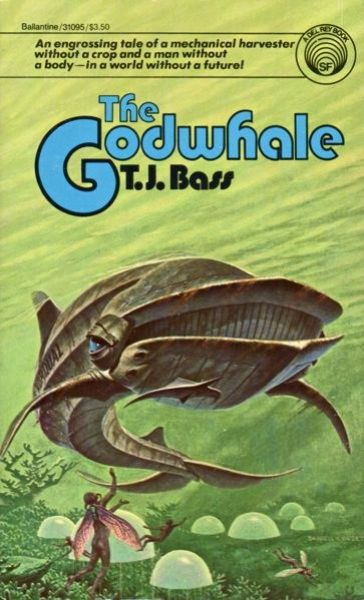Lost Voices 4: The Godwhale by T. J. Bass
The Godwhake
By T. J. Bass

24 Apr, 2000
0 comments
The Godwhale
T.J. Bass
Ballantine Books [1974]
281 pages
Synopsis: Larry Dever, several centuries in the future on an Earth with about 35 billion people, manages to get himself badly injured on a vacation. Too severely damaged for the technology of the day to cure completely [Having been more or less cut in two], he opts for Temporary Suspension, hoping to be woken in a future era with the ability to make him whole again. He is revived a few centuries later but while the method exists to give him a whole body, the method [raising a clone and using it for parts] seems unethical to him and re-opts for TS, missing a chance to join a seeding mission to Procyon.
Two thousand years pass. The Earth is occupied by the Hive, a world city covering all of the land and filled with 3.5 trillion four-toed nebbishes, the malnourished and degenerate descendants of current day humanity. The Hive has no room for useless people like Larry and it re-awakens him in order to urge him to commit suicide.
[The Hive AIs are not authorised to kill humans directly, so must use indirect methods. They ‑are- willing to play games with the definition of ‘human’ but Dever qualifies]. Dever escapes and makes an alliance with a tweenwaller, who is coincidentally a member of a clone group of Dever cell line. Eventually they escape via the Hive’s sewer systems and meet feral humans or our sort. People with any kind of disease or infection phobias will not enjoy the sewer scenes or the bot-fly incident.
The Rorqual Maru, the Godwhale of the title, is an intelligent ocean harvester, unable to serve in its intended function because the seas have been wiped clean of life. It sends a minor mech to the Hive to gather information on the current situation but the mech is ordered to submit to salvage.
Several years later, following a meteor storm, life begins to return to the seas. This is potentially useful to the Hive: it regains control of the Rorqual Maru and begins harvesting the seas again. The Hive is surprised when one of the sea dwelling feral humans is caught and killed in a net. They are more unpleasantly surprised when the second Benthic is still alive and proceeds to maim and kill a number of the crewmembers. The Nebbishes are incapable of dealing with the Benthics physically, so they decide to use the Larry Dever cell line to produce a super-warrior to protect the ships. The Hive is paranoid about the security risk the Arnolds represent so it has built in a serious amino acid deficiency to the Arnolds: without a special diet the Arnolds will die.
They then condition the Arnolds to be extremely aggressive and manage to cross-link the aggression with sexual impulses. Very few of the Nebbishes become sexually mature so the potential complications this cross linkage might cause are lost on them until the first Arnolds turns coat in order to pursue an attractive Benthic female. The Hive also loses control of the Rorqual Maru and subsequent attempts to recover it leads to the loss of many lesser ARNOLDS and several ships.
The Hive decides to negotiate. A plot by the steering committee leads to the death of several sympathetic characters, the destruction of a considerable part of the Hive and the elevation of the Benthics to a powerful position visa vis the Hive. The Hive decides to bide its time, having too few resources free from the struggle to keep 3.5 trillion Nebbishes fed to be able to afford the war its mishandling of the Benthic situation has made possible.
The book ends with the discovery that the re-appearance of life in the seas is due to an old starship, possibly the Procyon probe, reseeding the Earth with extinct life forms.
It’s a shame that this book and its companion, Half Past Human are out of print. As far as I know, Bass [a pen name of Dr. Thomas J. Bassler] only wrote two novels before leaving the field for reasons unknown to me. The plot is somewhat fragmented and reliant on coincidence [Larry Dever’s cell line keeps popping up, since the lower half of his bisected torso, preserved along with the talking half, provides a handy source of ancient genetic material]. Various characters appear far too well informed about matters biological given that the Benthics are savages and the Nebbishes are brain damaged from malnutrition. The book ends on a muddled and peculiar proof of the existence of a god of sorts1. Despite those flaws, the book and its companion novel are very energetic and a lot of fun. The descriptions of life in the Hive are vivid and terrible and the accounts of life in the sewers and the wild made me want to scrub down with antiseptic, especially the botfly episode and the account of the implication of Dever’s extensive injuries wrt survival in the wild.
Worth hunting down both books if you can find them. I think I saw a copy of Godwhale in Uncle Hugo’s in MPL last week, actually.
Next: The Taking of Satcon Station , Cohen and Baen
1: gy = c. If you multiply the gravity of Earth by its year, it equals the speed of light, esp of you pick a more or less arbitrary date to get the value of y you’ll need to make it work. They note that as y changes, it will sweep over a value where it equals some multiple of pi but dismiss ‑that- as a mere coincidence. Nggg. gy = c is how they are sorting planets for attempted colonisation…
